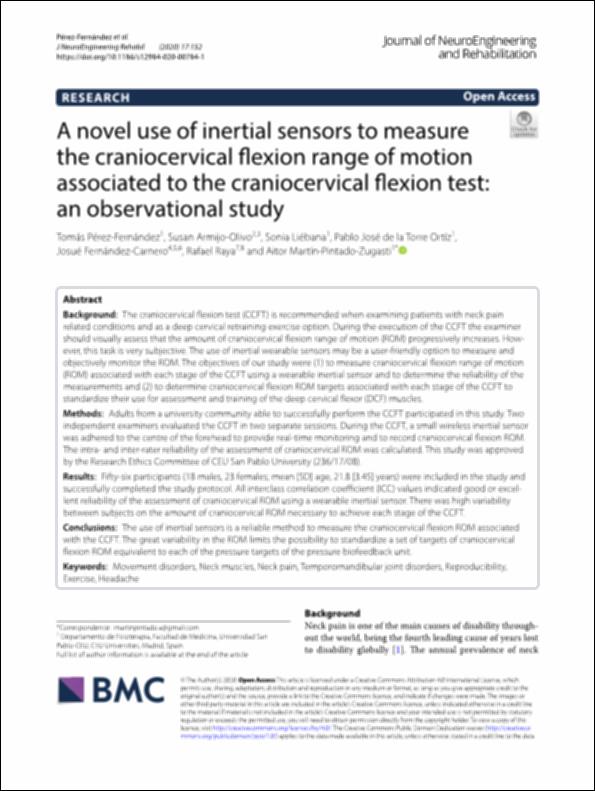Por favor, use este identificador para citar o enlazar este ítem:
http://hdl.handle.net/10637/14911A novel use of inertial sensors to measure the craniocervical flexion range of motion associated to the craniocervical flexion test: an observational study
| Título : | A novel use of inertial sensors to measure the craniocervical flexion range of motion associated to the craniocervical flexion test: an observational study |
| Autor : | Pérez Fernández, Tomás Armijo Olivo, Susan Liébana Sánchez-Toscano, Sonia Torre Ortíz, Pablo José de la Fernández Carnero, Josué Raya López, Rafael Martín‑Pintado Zugasti, Aitor |
| Materias: | Movement disorders; Neck muscles; Neck pain; Temporomandibular joint disorders; Reproducibility; Exercise; Headache |
| Editorial : | BMC |
| Citación : | Pérez-Fernández T, Armijo-Olivo S, Liébana S, de la Torre Ortíz PJ, Fernández-Carnero J, Raya R, Martín-Pintado-Zugasti A. A novel use of inertial sensors to measure the craniocervical flexion range of motion associated to the craniocervical flexion test: an observational study. J Neuroeng Rehabil. 2020 Nov 19;17(1):152. doi: 10.1186/s12984-020-00784-1. PMID: 33213452; PMCID: PMC7678052 |
| Resumen : | The craniocervical flexion test (CCFT) is recommended when examining patients with neck pain related conditions and as a deep cervical retraining exercise option. During the execution of the CCFT the examiner should visually assess that the amount of craniocervical flexion range of motion (ROM) progressively increases. However, this task is very subjective. The use of inertial wearable sensors may be a user-friendly option to measure and objectively monitor the ROM. The objectives of our study were (1) to measure craniocervical flexion range of motion (ROM) associated with each stage of the CCFT using a wearable inertial sensor and to determine the reliability of the measurements and (2) to determine craniocervical flexion ROM targets associated with each stage of the CCFT to standardize their use for assessment and training of the deep cervical flexor (DCF) muscles. |
| URI : | http://hdl.handle.net/10637/14911 |
| Derechos: | OpenAccess http://creativecommons.org/licenses/by/4.0/deed.es |
| ISSN : | 1743-0003 |
| Fecha de publicación : | 19-nov-2020 |
| Centro : | Universidad San Pablo-CEU |
| Aparece en las colecciones: | Fisioterapia |
Los ítems de DSpace están protegidos por copyright, con todos los derechos reservados, a menos que se indique lo contrario.


